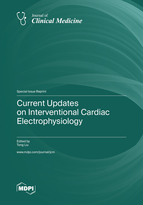Current Updates on Interventional Cardiac Electrophysiology
A special issue of Journal of Clinical Medicine (ISSN 2077-0383). This special issue belongs to the section "Cardiology".
Deadline for manuscript submissions: closed (25 July 2023) | Viewed by 26206
Special Issue Editor
Special Issue Information
Dear Colleagues,
Rapid developments have taken place over the recent years in the interventional cardiac electrophysiology. New methods and tools in the diagnosis and treatment of cardiac arrhythmia have emerged. There are many questions which still present a challenge, such as the ablation of refractory ventricular tachycardia, how to improve the long-term success rate of persistent atrial fibrillation, the long-term effectiveness and safety of His–Purkinje conduction system pacing. Accordingly, we dedicate this Special Issue Current Updates on Interventional Cardiac Electrophysiology to gathering the most recent progress in this field. Its aim is to present an overview of the current knowledge, latest evidence, and unresolved issues in this field. More specifically, the topics of interest include but are not limited to: atrial fibrillation; cryoablation; radiofrequency ablation; cardiac resynchronization therapy; His–Purkinje conduction system pacing; stereotactic radiotherapy for refractory ventricular tachycardia; pulsed electric field ablation; leadless pacemakers; and implantable cardioverter-defibrillators.
Prof. Dr. Tong Liu
Guest Editor
Manuscript Submission Information
Manuscripts should be submitted online at www.mdpi.com by registering and logging in to this website. Once you are registered, click here to go to the submission form. Manuscripts can be submitted until the deadline. All submissions that pass pre-check are peer-reviewed. Accepted papers will be published continuously in the journal (as soon as accepted) and will be listed together on the special issue website. Research articles, review articles as well as short communications are invited. For planned papers, a title and short abstract (about 100 words) can be sent to the Editorial Office for announcement on this website.
Submitted manuscripts should not have been published previously, nor be under consideration for publication elsewhere (except conference proceedings papers). All manuscripts are thoroughly refereed through a single-blind peer-review process. A guide for authors and other relevant information for submission of manuscripts is available on the Instructions for Authors page. Journal of Clinical Medicine is an international peer-reviewed open access semimonthly journal published by MDPI.
Please visit the Instructions for Authors page before submitting a manuscript. The Article Processing Charge (APC) for publication in this open access journal is 2600 CHF (Swiss Francs). Submitted papers should be well formatted and use good English. Authors may use MDPI's English editing service prior to publication or during author revisions.
Keywords
- atrial fibrillation
- cryoablation
- radiofrequency ablation
- cardiac resynchronization therapy
- His-Purkinje conduction system pacing
- stereotactic radiotherapy for refractory ventricular tachycardia
- pulsed electric field ablation
- leadless pacemakers
- implantable cardioverter-defibrillators







